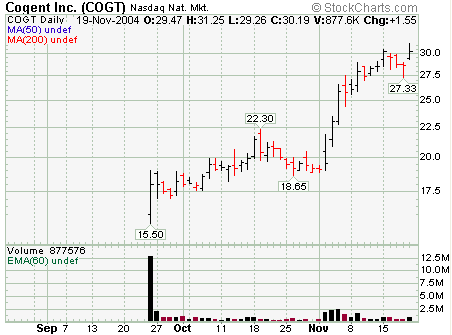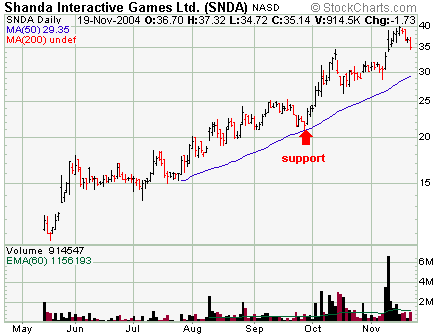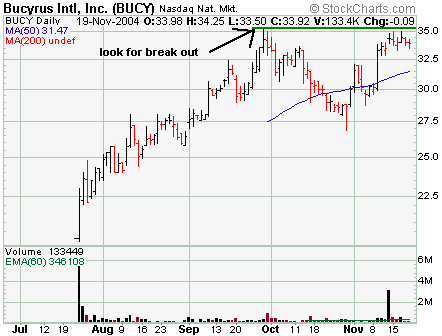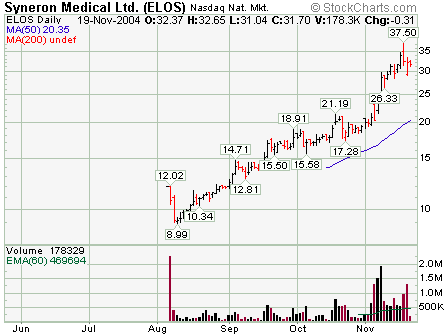(my apologies for the array of font sizes and styles – the transfer didn’t go as well as planned.. I suppose variety isn’t so bad. As always click on the thumbnail charts for the larger version)
Over the past couple of months, a slew of successful IPO’s have hit the market, renewing excitement not seen since the good ‘ol days of the late 90’s. Most investors are well aware of the biggest IPO in history – Google, which soared more than 100% in less than 3 months. But there are other less recognized names that have gone on to equally astonishing gains in very little time. The goal of this special report is to highlight some of these companies and introduce you to what could possibly be the biggest IPO of the year, PortalPlayer.
Before I begin, I’d like to discuss the best way to go about purchasing an IPO. William O’neil, the founder of CANSLIM has often stated that the best way to go about it is to wait for the stock to carve out its first base, shaking out the speculators in the process. I would have to agree that this is the safest way to profit from an emerging leader new to the market. By waiting, you’ll also have a better idea as to the stocks "history". By history I mean the amount of volatility in the stock, volume patterns as well as support and resistance areas. However, (there’s always a however right?) depending on your appetite for risk, purchasing a small position within the first 30 days can be very profitable. Here are a few things to consider when making a purchase in an IPO
-
First of all, make sure the company is growing and making money (all of the stocks highlighted in this report are).
-
Once the lockup period is over (the period where insiders are unable to unload shares), the stock price could come under some selling pressure as the supply of shares increases. Conversely, during this period, the combination of high demand and a lock on supply can fuel big gains. Lock up periods are usually around 180 days, but can vary from company to company. For example Google has decided to go with a series of lockup dates to avoid dumping the entire amount in one day. The first large release of shares to the market occurred on Tuesday, November 16th when the size of the float (the number of shares available for trading by the public) more than doubled with the release of 39 million shares. Subsequent lockup periods will end in mid December, January and February. On February 14th, the last day of the lockup period, 170 million shares will flood the market. Watch to see how this affects the stock price. Does the stock bounce back after some selling pressure? If so, that means the institutional demand for the stock outweighs the increase in supply. The sign of a strong stock.
-
Immediately upon expiration of the quiet period (40 days from public offer), analysts affiliated with investment banks that participated as the lead underwriter or as a co-manager in the deal typically initiate favorable research coverage. What can happen is that an IPO will run up in price several days before the quiet period ends in anticipation that favorable coverage will be initiated and then sell off once the recommendation is released. Just another example of "buy on the rumor, sell on the news".
Ok, let’s get to it. The following companies are exhibiting outstanding growth and have recently come to market with their IPO. Of course, all companies highlighted here are merely suggestions and are not a buy recommendation. As always, please do your research and/or consult your financial advisor before making any purchase.
Portal Player (PLAY)
In what could be one of the biggest IPO’s of the year, Portal Player began trading publicly on Friday, closing at 26.06 (good for a 53% gain from its initial offer price of $17/share – the stock opened trading above $25/share, so you didn’t miss much).
As a supplier of the guts that make up the "must have" Apple Ipod, the hype in this company is well founded. Since establishing a relationship with Apple, the company has enjoyed astonishing growth, especially in the recently reported quarter ending in September (the first profitable quarter in the company’s history). In fact, the company increased earnings 450% and sales 113% from the previous quarter! That kind of growth over an entire year would be impressive.. but 3 months? Wow. Imagine what kind of growth they’ll report after this quarter, with the Ipod expected to be near the top of many Christmas wish lists. The future looks bright as well, with the hard drive based MP3 market expected to increase 60% a year for the next few years.
Of course, big rewards and risks go hand in hand. While the relationship with Apple has obviously led to good fortunes for this company, it is both a blessing and a curse. With 93% of sales coming from sales of the Ipod, any change in this relationship or problems on Apple’s end would be a big blow to the company. In addition, as the market for portable MP3 players continues to expand, you better believe that other companies will want a piece of the pie.
Whether you have a position in this stock or are on the sidelines, it will no doubt be fun to watch this one!
Cogent (COGT)

Cogent, Inc. is a provider of automated fingerprint identification systems (AFIS) and other fingerprint biometrics solutions to governments, law enforcement agencies and other organizations worldwide. The Company’s AFIS solutions enable customers to capture fingerprint images electronically, encode fingerprints into searchable files and compare a set of fingerprints. The Company’s AFIS solutions include Cogent automated fingerprint identification system and Cogent live-ID; Its AFIS products include programmable matching accelerator servers and live-scan systems; Cogents AFIS services include the design, integration and training, as well as outsourced live-ID biometric processing services, and the Company’s ASIC applications include BioGate, national identification card programs and MobileIDENT. Cogent offers all of the elements to deploy fingerprint biometric solutions, including search and retrieval software, capture devices and systems integration services.
In the past few months Cogent has received contracts totaling 74 million from the National Electoral Council in Venezuela to install a "one voter, one vote" system using its fingerprint identification technology. In late September, Fujitsu Microelectronics America announced that Cogent’s software had been integrated into the JumpDrive TouchGuard, the newest USB portable storage product from Lexar Media that replaces awkward passwords with the convenience of a finger swipe to control access to data stored on the device. Just last week, Cogent, Inc. announced that it has completed the activation of its Automatic Fingerprint Identification System (AFIS) for the Department of Public Safety and State Police in Connecticut and Rhode Island. The total contract and orders are valued at approximately $10 million.
Financials
Cogent is a company that has seen its earnings and sales surge over the past year. Quarter over quarter sales growth has come in at 390%, 295%, 224% and 687%, while earnings growth in the same time period has been equally, if not more impressive with growth of 999%, 600%, 800% and 600%. Earnings growth is expected to slow in ’05, but remain strong with growth of 51%. The company enjoys a strong balance sheet with rising margins (net margin currently at 55%) and 208 million in cash.
Technical
Since the IPO, Cogent has run up nearly 100%, balking at the thought of carving out a decent base. A pull back is certainly in order as it appears overbought at this point. With no clear support areas, it makes it difficult to make a sound buy decision, but I would expect support to be in the 22.50 – 25 range which might offer a reasonable place to initiate a small position. A better strategy is waiting for the stock to carve out a decent base and purchasing at a breakout from consolidation.
Shanda Interactive (SNDA)
 Shanda Interactive Entertainment Limited (Shanda) is an operator of online games in China. It offers a portfolio of online games that users play over the Internet. The games, licensed from third parties, as well as developed in-house by the Company, include The Legend of Mir II and The World of Legend. Shanda’s commercially launched games have approximately 1.4 million peak concurrent users and 931,570 average concurrent users. The Company operates massively multiplayer online games (MMOGs), including massively multiplayer online role-playing games (MMORPGs) and casual online games. MMORPGs allow thousands of users to interact in a virtual world by assuming ongoing roles or characters with different features. The games are continuous, and players accumulate features and communicate with one another through instant messaging. Casual games, which include BNB, are less complex and time consuming than MMORPGs, but attract a broader range of users, including more home users. Considering that 90% of the Chinese population is still offline, there remains a large, untapped market of potential gamers.
Shanda Interactive Entertainment Limited (Shanda) is an operator of online games in China. It offers a portfolio of online games that users play over the Internet. The games, licensed from third parties, as well as developed in-house by the Company, include The Legend of Mir II and The World of Legend. Shanda’s commercially launched games have approximately 1.4 million peak concurrent users and 931,570 average concurrent users. The Company operates massively multiplayer online games (MMOGs), including massively multiplayer online role-playing games (MMORPGs) and casual online games. MMORPGs allow thousands of users to interact in a virtual world by assuming ongoing roles or characters with different features. The games are continuous, and players accumulate features and communicate with one another through instant messaging. Casual games, which include BNB, are less complex and time consuming than MMORPGs, but attract a broader range of users, including more home users. Considering that 90% of the Chinese population is still offline, there remains a large, untapped market of potential gamers.
The company is continuing to expand its business through strategic acquisitions and investments. Recently, Shanda has completed acquisitions of Bianfeng, a developer and operator of online chess and other board games, Quidian, an interactive online literature portal as well as Digital Red, a developer of games for mobile phones. While not yet contributing a major portion of revenues, the fastest growing segment of the company is online advertising. In October, Shanda announced a strategic relationship with EbayEachNet, a subsidiary of eBay, that places EbayEachNet advertising on Shanda websites. One concern with the company that has yet to be resolved is its ongoing rift with China Telecom which began selling its discount gaming cards at a greater discount than the company was selling them for. Shanda has threatened to end the contract with China Telecom, while China Telecom has threatened to cut off its internet access. Can’t we all just get along!
Financials
Over the course of the past year, earnings and sales growth has remained strong with quarter over quarter sales growth for the past 4 quarters of 126%, 63%, 109% and 133%, while earnings growth has come in at 100%, 8%, 60% and 93%. Net profit margins have remained steady in the past few years at around 45% which is excellent. Return on equity, while still strong at 23% has been declining for the past few years.
Technical
Shanda has nearly tripled in price since its IPO and is well overdue for a correction. Jumping in at this point would be a mistake. Wait for a pull back to the 50DMA, where it was able to find support at the end of September. A bounce off support may offer a buying opportunity, but a more likely scenario is for the stock to carve its first significant base. It’s possible that the uncertainty surrounding the relationship with China Telecom could provide the catalyst for a correction.
Note: While Shanda is certainly a company to keep an eye one, another way to invest in the growth of Chinese online gaming is SINA which is a larger, more established company that has solidified its position as a leader with its relationship with Yahoo.
Bucyrus International (BUCY)
 Bucyrus International, Inc. designs, manufactures and markets large excavation machinery used for surface mining, and provides aftermarket services, supplying replacement parts and offering maintenance and repair contracts and services for these machines. The Company manufactures its original equipment manufactured (OEM) products and manufactured aftermarket parts at its facility in South Milwaukee, Wisconsin. Its principal OEM products are draglines, electric mining shovels and rotary blasthole drills, which are used primarily by customers who mine copper, coal, oil sands and iron ore throughout the world. In addition, the Company provides aftermarket services in mining centers throughout the world, including Argentina, Australia, Brazil, Canada, Chile, China, England, India, Peru, South Africa and the United States. The largest markets for this mining equipment have been in the United States, South America, Australia, South Africa and Canada.
Bucyrus International, Inc. designs, manufactures and markets large excavation machinery used for surface mining, and provides aftermarket services, supplying replacement parts and offering maintenance and repair contracts and services for these machines. The Company manufactures its original equipment manufactured (OEM) products and manufactured aftermarket parts at its facility in South Milwaukee, Wisconsin. Its principal OEM products are draglines, electric mining shovels and rotary blasthole drills, which are used primarily by customers who mine copper, coal, oil sands and iron ore throughout the world. In addition, the Company provides aftermarket services in mining centers throughout the world, including Argentina, Australia, Brazil, Canada, Chile, China, England, India, Peru, South Africa and the United States. The largest markets for this mining equipment have been in the United States, South America, Australia, South Africa and Canada.
Fundamentals
Bucyrus is a company that has just recently turned profitable (first profitable quarter in June ’04), capitalizing on the strength of the commodity industry. Earnings have been impressive recently, especially in the last two quarters with quarter over quarter growth of 625% and 377%. Growth in earnings is expected to continue to surge through ’05 with estimates of 151% growth over 2004. Margins remain poor, but they have been improving each year for the past few years.
Technical
After running up nearly 100% in just a couple of months, the stock has carved out a short base on analyst valuation concerns and a secondary offering which has been completed. A break out above recent consolidation may offer a buying opportunity. Look for volume to surge as it does so.
Syneron Medical (ELOS)
 Syneron Medical Ltd., incorporated in July 2000, designs, develops and markets aesthetic medical products based on electro-optical synergy (ELOS) technology, which uses the synergy between electrical energy and optical energy to provide effective, safe and affordable aesthetic medical treatments. The ELOS technology combines optical energy, which is derived from light waves, with electrical energy, in particular radio frequency energy that results from the flow of electric charge through a conductor. This combination enhances the user’s ability to target accurately the tissue to be treated and enables real-time measurement of skin temperature, resulting in increased patient safety and comfort and improved treatment results. The Company’s products are sold primarily to physicians and other practitioners, target a wide array of non-invasive aesthetic medical procedures, including hair removal, wrinkle reduction and rejuvenating the skin’s appearance through the treatment of superficial benign vascular and pigmented lesions.
Syneron Medical Ltd., incorporated in July 2000, designs, develops and markets aesthetic medical products based on electro-optical synergy (ELOS) technology, which uses the synergy between electrical energy and optical energy to provide effective, safe and affordable aesthetic medical treatments. The ELOS technology combines optical energy, which is derived from light waves, with electrical energy, in particular radio frequency energy that results from the flow of electric charge through a conductor. This combination enhances the user’s ability to target accurately the tissue to be treated and enables real-time measurement of skin temperature, resulting in increased patient safety and comfort and improved treatment results. The Company’s products are sold primarily to physicians and other practitioners, target a wide array of non-invasive aesthetic medical procedures, including hair removal, wrinkle reduction and rejuvenating the skin’s appearance through the treatment of superficial benign vascular and pigmented lesions.
Recently, Syneron has released a series of positive announcements, solidifying its place in the non invasive aesthetics industry. On October 18th, the company announced the Health Canada approval for the VelaSmooth, its new aesthetic device for body contouring and the treatment of cellulite. The VelaSmooth is a medical device that reduces the appearance of cellulite and safely and effectively re-contours the skin’s surface and body shape. Its launch marks a new era in the medical treatment of cellulite. On October 25th, the company announced that the US Food & Drug Administration (FDA) has granted 510K marketing clearance to Syneron’s Aurora(TM) and its derivative systems for "removal of unwanted hair from skin types I-VI, and to effect stable long-term, or permanent, hair reduction". This new clearance expands on the previous clearance for hair reduction granted in July 2002, reflecting the excellent long-term results documented in more than 24 months of clinical studies. Last week, the company was granted Medical CE Mark 0344 approval of its Vela(TM) system for non-invasive cellulite treatment in Europe. "This unique medical CE Mark further proves that Syneron products meet the exacting quality and efficacy standards of the international medical community," said Hans Edel, Managing Director of Syneron GmbH. "With this latest regulatory approval, Syneron is able to market the widest offering of products in Europe of any medical aesthetic company."
The non-invasive aesthetic procedure industry is a rapidly growing field with many competitors (see Palomar (PMTI) and Laserscope (LSCP) – both are also rapidly growing companies. Palomar has the luxury of a partnership with GE to assist in product development and marketing). According to IBD, Syneron separates itself from competitors by offering the customer more than just the device. It has lined up an insurer that cut its malpractice premiums for procedures done with Syneron gear. Additionally, the company sends in a consultant to evaluate the doctor’s practice and provides a 3 year warranty.
Fundamentals
From the company’s inception in 2001, growth has been nothing short of amazing. In 2002 and 2003, the company grew earnings 300% and 320% respectively, with growth expected to exceed 170% for 2004. However, growth is expected to ease in ’05 with estimates of 11% growth. I would expect those estimates to be revised upward as recent product approvals lead to increasing sales. Profit margins are excellent and nearly double that of its nearest competitors, Laserscope and Palomar Tech. The company has an impressive balance sheet with 90 million in cash and no debt.
Technical
Another IPO that has soared since coming to market, having yet to carve out a base. In fact, it hasn’t yet come close to testing support of the 50 day moving average. Wait for a pull back to the 50DMA to see if it bounces. If so, it may offer an opportunity for some short term profits. Looking longer term, look to initiate a larger position after the stock has had a chance to carve out its first base.
Other Rapidly Growing IPO’s to Watch
- Google (GOOG) of course! Stock is carving out it’s first base – look for a pull back to the 50 day moving average as a buy opportunity. Stock faces increasing pressure as lock up periods expire and supply expands.
- Rightnow Techonologies (RNOW): provider of integrated customer relationship software is consolidating gains after tripling in four months
- 51job Inc. (JOBS): provider of integrated human resource services in China has doubled in price since going public in late September and has yet to carve out its first base
- Kanbay International (KBAY): global provider of information technology services to the financial industry has shown good institutional support by bouncing off support levels – it is weakening technically and may be carving out its first base
- Westllake Chemical (WLK): its been up, up and away for this manufacturer and marketer of basic chemicals – the stock has more than doubled since its IPO and has not come close to testing major support. Wait for a pull back to the 50 day moving average as a potential buy opportunity
- VNUS Medical (VNUS): provider of minimally invasive treatment of venous reflux disease is wasting no time in carving out its first base – after surging in the first few days of its IPO, the stock has plummeted in recent days to begin the left side of a potential base.
The above report was sent to SelfInvestors.com members several days ago – if you’d like to receive these special reports as well as market outlook and industry reports, you may sign up at www.selfinvestors.com.